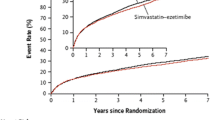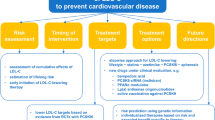Summary
Statin-mediated lowering of low-density lipoprotein cholesterol (LDL-C) is regarded as the foundation of lipid-modifying therapy. However, the residual cardiovascular risk for statin-treated patients remains high, indicating the need for therapeutic intervention against other lipid targets as well as non-lipid risk factors. Low levels of high-density lipoprotein cholesterol (HDL-C) are established as a strong independent risk factor for cardiovascular disease. Intervention studies have also demonstrated clinical benefits associated with HDL-C raising. Although lifestyle modification does play an important role in raising HDL-C, most patients with a low HDL-C and at high risk of coronary events also require pharmacological treatment to achieve the target. Of the available treatment options, nicotinic acid is the most potent agent for raising HDL-C (by 26% at clinically recommended doses), while substantially lowering triglycerides and LDL-C. The addition of nicotinic acid to primary statin therapy is a logical approach to dyslipidaemia management, given their complementary mechanism of action, and is supported by recent clinical trials such as the Arterial Biology for the Investigation of the Treatment Effects of Reducing cholesterol (ARBITER) 2 study. Raising HDL-C will increasingly become an important secondary focus of dyslipidaemia management.
Similar content being viewed by others
References
Expert Panel on Detection. Evaluation, and Treatment of High Blood Cholesterol in Adults. Executive summary of the Third Report of the National Cholesterol Education Program (NCEP) Expert Panel on detection, evaluation, and treatment of high blood cholesterol in adults (Adult Treatment Panel III). JAMA 2001;285:2486–2497.
International Atherosclerosis Society. Harmonized clinical guidelines on prevention of atherosclerotic vascular disease. Available at http://www.athero.org.
Backer G, Ambrosioni E, Borch-Johnsen K, et al. Executive summary. European guidelines on cardiovascular disease prevention in clinical practice. Third Joint Task Force of European and other Societies on Cardiovascular Disease Prevention in Clinical Practice. Eur Heart J 2003;24:1601–1610.
Sacks FM, Tonkin AM, Shepherd J, et al. Effect of pravastatin on coronary disease events in subgroups defined by coronary risk factors. The Prospective Pravastatin Pooling Project. Circulation 2000;102:1893–1900.
Ballantyne CM, Olsson AG, Cook TJ, Mercuri M, Pedersen TR, Kjekshus J. Influence of low high-density lipoprotein cholesterol and elevated triglyceride on coronary heart disease events and response to simvastatin therapy in 4S. Circulation 2001;104:3046–3051.
Cannon CP, Braunwald E, McCabe CH, et al. Intensive versus moderate lipid lowering with statins after acute coronary syndromes. N Engl J Med 2004;350:1495–1504.
Nissen SE, Tuzcu EM, Schoenhagen P, et al. Effect of intensive compared with moderate lipid-lowering therapy on progression of coronary atherosclerosis. JAMA 2004;291:1071–1080.
La Rosa JC, Grundy SM, Waters DD, et al. Intensive lipid lowering with atorvastatin in patients with stable coronary disease. N Engl J Med 2005;352:1425–1435.
Gordon T, Castelli WP, Hjortland MC, Kannel WB, Dawber TR. High density lipoprotein as a protective factor against coronary heart disease. The Framingham Study. Am J Med 1977;62:707–714.
Assmann G, Schulte H, von Eckardstein A, Huang Y. High-density lipoprotein cholesterol as a predictor of coronary heart disease risk. The PROCAM experience and pathophysiological implications for reverse cholesterol transport. Atherosclerosis 1996;124(Supp l):S11–S20.
Gordon DJ, Probstfield JL, Garrison RJ, et al. High-density lipoprotein cholesterol and cardiovascular disease. Four prospective American studies. Circulation 1989;79:8–15.
Yusuf S, Hawken S, Ounpuu S, et al. Effect of potentially modifiable risk factors associated with myocardial infarction in 52 countries (the INTERHEART study): case-control study. Lancet 2004;364:937–952.
Manninen V, Elo MO, Frick MH, et al. Lipid alterations and decline in the incidence of coronary heart disease in the Helsinki Heart Study. JAMA 1988;260:641–651.
Rubins HB, Robins SJ, Collins D, et al. Gemfibrozil for the secondary prevention of coronary heart disease in men with low levels of high-density lipoprotein cholesterol. N Engl J Med 1999;341:410–418.
Robins SJ, Collins D, Wittes JT, et al. Relation of gemfibrozil treatment and lipid levels with major coronary events. VA-HIT: a randomized controlled trial. JAMA 2001;285:1585–1591.
The IDF consensus worldwide definition of the metabolic syndrome. April 14, 2005. Available from http://www.idf.org.
Turner RC, Millns H, Neil HA, et al. Risk factors for coronary artery disease in non-insulin dependent diabetes mellitus (UKPDS 23). BMJ 1998;316:823–828.
Cappuccio FP, Barbato A, Kerry SM. Hypertension, diabetes and cardiovascular risk in ethnic minorities in the UK. Br J Diabetes Vasc Dis 2003;3:286–293.
Anand S, Enas E, Pogue J, et al. Elevated lipoprotein(a) levels in South Asians in North America. Metabolism 1998;47:182–184.
Bhopal R. What is the risk of coronary heart disease in South Asians? A review of UK research. J Pub Health Med 2000;22:375–385.
Drexel H, Aczel S, Marte T, et al. Is atherosclerosis in diabetes and impaired fasting glucose driven by elevated LDL cholesterol or by decreased HDL cholesterol? Diabetes Care 2005;28:101–107.
Taskinen M-R. Diabetic dyslipidaemia: from basic research to clinical practice. Diabetologia 2003;46:733–749.
Moffatt RJ, Chelland SA, Pecott DL, Stamford BA. Acute exposure to environmental tobacco smoke reduces HDL-C and HDL2-C. Prev Med 2000;38:637–641.
Kelley GA, Kelley KS, Tran ZV. Walking, lipids, and lipoproteins: a meta-analysis of randomized controlled trials. Prev Med 2004;38:651–661.
Rimm EB, Williams P, Fosher K, Criqui M, Stampfer MJ. Moderate alcohol intake and lower risk of coronary heart disease: meta-analysis of effects on lipids and haemostatic factors. BMJ 1999;319:1523–1528.
Chapman MJ, Assman G, Fruchart JC, Shepherd J, Sirtori C, on behalf of the European Consensus Panel on HDL-C. Raising high-density lipoprotein cholesterol with reduction of cardiovascular risk: the role of nicotinic acid- a position paper developed by the European Consensus Panel on HDL-C. Curr Med Res Opin 2004;20:1253–1268.
Sacks FM. The role of high-density lipoprotein (HDL) cholesterol in the prevention and treatment of coronary heart disease: expert group recommendations. Am J Cardiol 2002;90:139–143.
Downs JR, Clearfield M, Weis S, et al. Primary prevention of acute coronary events with lovastatin in men and women with average cholesterol levels : results of AFCAPS/TexCAPS. Air Force /Texas Coronary Athersclerosis Prevention Study. JAMA 1998;279:1615–1622.
Chapman MJ. Fibrates in 2003: therapeutic action in atherogenic dyslipidaemia and future perspectives. Atherosclerosis 2003;171:1–13.
Belalcazar LM, Ballantyne CM. Defining specific goals of therapy in treating dyslipidemia in the patient with low high-density lipoprotein cholesterol. Progr Cardiovasc Dis 1998;41:151–174.
Birjmohun RS, Hutten BA, Kastelein JJP, Stroes ESG. Efficacy and safety of high-density lipoprotein cholesterol-increasing compounds. A meta-analysis of randomized controlled trials. J Am Coll Cardiol 2005;45:185–197.
Frick MH, Syvanne M, Nieminen MS, et al. Prevention of the angiographic progression of coronary and vein-graft atherosclerosis by gemfibrozil after coronary bypass surgery in men with low levels of HDL cholesterol. Circulation 1997;96:2137–2143.
Effect of fenofibrate on progression of coronary-artery disease in type 2 diabetes: the Diabetes Atherosclerosis Intervention Study, a randomised study. Lancet 2001;357:905–910.
Wierzbicki AS, Mikhailidis DP, Wray R, et al. Statin-fibrate combination therapy for hyperlipidaemia: a review. Curr Med Res Opin 2003;19:155–168.
Guyton JR. Extended-release niacin for modifying the lipoprotein profile. Expert Opin Pharmacother 2004;5:1385–1398.
Guyton JR, Blazing MA, Hagar J, et al. Extended-release nicotinic acid vs gemfibrozil for the treatment of low levels of high-density lipoprotein cholesterol. Niaspan-Gemfibrozil Study Group. Arch Intern Med 2000;160:1177–1184.
Morgan JM, Capuzzi DM, Baksh RI, et al. Effects of extended-release niacin on lipoprotein subclass distribution. Am J Cardiol 2003;91:1432–1436.
Coronary Drug Project Research Group. Clofibrate and niacin in coronary heart disease. JAMA 1975;231:360–381.
Canner PL, Berge KG, Wenger NK, et al. Fifteen year mortality in Coronary Drug Project patients: long-term benefit with niacin. J Am Coll Cardiol 1986;8:1245–1255.
Canner PL, Furberg CD, Terrin ML, McGovern ME. Benefits of niacin by glycemic status in patients with healed myocardial infarction (from the Coronary Drug Project). Am J Cardiol 2005;95:254–257.
Canner PL, Furberg CD, Terrin ML, McGovern ME. Niacin decreases myocardial infarction and total mortality in patients with metabolic syndrome: results from the Coronary Drug Project. J Am Coll Cardiol 2003;41(Suppl A):291A (abstract).
Elam MB, Hunninghake DB, Davis KB, et al. Effect of niacin on lipid and lipoprotein levels and glycemic control in patients with diabetes and peripheral arterial disease. The ADMIT study: a randomized trial. JAMA2000;284:1263–1270.
Grundy SM, Vega GL, McGovern ME, et al. Efficacy, safety, and tolerability of once-daily niacin for the treatment of dyslipidemia associated with type 2 diabetes. Results of the Assessment of Diabetes control and Evaluation of the Efficacy of Niaspan Trial. Arch Intern Med 2002;162:1568–1576.
American Diabetes Association. Dyslipidaemia management in adults with diabetes. Diabetes Care 2004;27(Suppl 1):S68–S71.
Wolfe ML, Vartanian SF, Ross JL, et al. Safety and effectiveness of Niaspan when added sequentially to a statin for treatment of dyslipidemia. Am J Cardiol 2001;87:476–479.
Kashyap ML, McGovern ME, Berra K, et al. Long-term safety and efficacy of a once-daily nicotinic acid/lovastatin formulation for patients with dyslipidemia. Am J Cardiol 2002;89:672–678.
Grundy SM, Vega GL, McGovern ME, et al. Comparative effects on lipids and glycaemic control of niacin extended-release/lovastatin or fenofibrate in patients with diabetic dyslipidaemia. [American Diabetes Association Annual Meeting 2004, Abstract No. 29-LB].
Brown BG, Zhao XQ, Chait A, et al. Simvastatin and nicotinic acid, antioxidant vitamins, or the combination for the prevention of coronary disease. N Engl J Med 2001;345:1583–1592.
Taylor AJ, Sullenberger LE, Huyn JL, Lee JK, Grace KA. Arterial Biology for the Investigation of the Treatment Effects of Reducing cholesterol (ARBITER) 2. A double-blind, placebo-controlled study of extended-release niacin on atherosclerosis progression in secondary prevention patients treated with statins. Circulation 2004;110:3512–3517.
Greenland P, Abrams J, Aurigemma GP, et al. AHA Scientific Statement. Prevention Conference V. Beyond secondary prevention: identifying the high-risk patient for primary prevention: non-invasive tests of atherosclerotic burden: Writing Group III. Circulation 2000;101:e16–e22.
Knopp RH, Alagona P, Davidson M, et al. Equivalent efficacy of a time-release form of nicotinic acid (Niaspan) given once-a-night versus plain nicotinic acid in the management of hyperlipidemia. Metabolism 1998;47:1097–1104.
Barter PJ, Brewer HB Jr, Chapman MJ, Hennekens CH, Rader DJ, Tall AR. Cholesteryl ester transfer protein: a novel target for raising HDL and inhibiting atherosclerosis. Arterioscler Thromb Vasc Biol 2003;23:160–167.
De Grooth GT, Kuivenhoven JA, Stalenhoef AFH, et al. Efficacy and safety of a novel cholesteryl ester transfer protein inhibitor, JTT-705, in humans. Circulation 2002;105:2159–2165.
Clark RW, Sutfin TA, Ruggeri RB, et al. Raising high-density lipoprotein in humans through inhibition of cholesteryl ester transfer protein. An initial multidose study of torcetrapib. Arterioscler Thromb Vasc Biol 2004;24:490–497.
Brousseau ME, Schaefer EJ, Wolfe MI, et al. Effects of an inhibitor of cholesteryl ester transfer protein on HDL cholesterol. N Engl J Med 2004;350:1505–1515.
Brewer HB. Increasing HDL cholesterol levels. N Engl J Med 2004;350:1491–1494.
de Grooth GJ, Klerkx AH, Stroes ES, et al. A review of CETP and its relation to atherosclerosis. J Lipid Res 2004;45:1967–1974.
Nofer JR, Kehrel B, Fobker M, et al. HDL and atherosclerosis: beyond reverse cholesterol transport. Atherosclerosis 2002;161:1–16.
Author information
Authors and Affiliations
Corresponding author
Additional information
This review was funded by an educational grant from Merck KGaA.
Rights and permissions
About this article
Cite this article
Schachter, M. Strategies for Modifying High-Density Lipoprotein Cholesterol: A Role for Nicotinic Acid. Cardiovasc Drugs Ther 19, 415–422 (2005). https://doi.org/10.1007/s10557-005-5685-0
Published:
Issue Date:
DOI: https://doi.org/10.1007/s10557-005-5685-0




